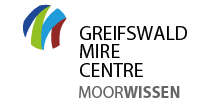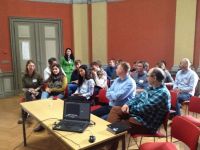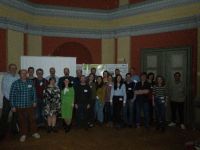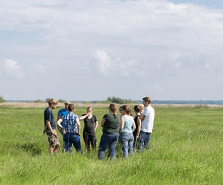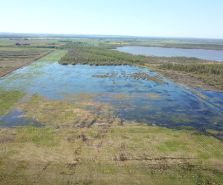Events, News and Outputs
Activities in the DESIRE project started at the beginning of 2019. Here some selected highlights are presented. Below there is a list of events organized and outputs created by the DESIRE project. Please click on the respective link for more information. The list is regularly updated.
1 Project management and administration
Final workshop "Rewetting and sustainable use of peatlands"
As part of a series of workshops of the Waterdrive Interreg project, a workshop was organised on 19.11.2021 on "Rewetting and sustainable use of peatlands". With this event, content on peatland issues and paludiculture could be communicated to the projects own clientele, but also to the Waterdrive stakeholders (land and water management). More than 65 people took part and were able to actively put forward their arguments for discussion in breakout groups. A summary/protocol can be found here.
End of project conference INTERREG-DESIRE Projekts “Peatlands and nutrients"
The final conference of the INTERREG-DESIRE project "Peatlands and nutrients" was organised on 24.11.2021 with more than 40 participants. The online meeting met with great interest and active participation of the participants. A summary of the event can be found here.
Kick-off meeting in Greifswald (20-21 March, 2019)
The kickoff meeting was held in the time-honored ambience of the Greifswald International Meeting Centre „Felix Haussdorf“. The minutes to this meeting can be found here.
Photos: Kick off meeting in the International meeting centre in Greifswald. (Bilder: Wichtmann)
Afterwards there was an excursion to a restored coastal floodplain peatland (Karrendorfer Wiesen) near Greifswald which gave a good impression on restoration of peatlands and scientific monitoring.
2 Policies for improved peatlands management and decision making on peatlands rewetting
Across Europe: INNOVATION & INSPIRATION. State of the Art & Guide to Next Steps
For World Peatlands Day (2nd of June 2021) five EU transnational projects exploring innovative measures to save our peatlands have released the Peatlands Across Europe: Innovation and Inspiration guide outlining their experiences and recommendations. This brochure presents projects Carbon Connects, Care-Peat, DESIRE, LIFE Peat Restore, and CANAPE. The document aims to pave the way for future action on peatlands. Download: PDF.
2.1 Inventory of peatlands in the Neman basin
The need to balance both the utilization and the conservation of natural resource management calls for spatial planning at multiple levels (strategic, tactical and operational). One work package of the DESIRE project provides spatial planning at both the strategic and tactical levels by evaluating the representativeness of peatlands in the Neman River basin in the Baltic Sea Region. Therefore DESIRE developed an online web mapping tool, and a test version can be found on www.neman-peatlands.eu. It’s an interactive map containing spatial data with parcels of separate peatlands, presented in a grid of 500 ha cells of entire catchment. The database contains major peatland statistics, e.g. peatland type, land use, conservation status, drainage status etc. Peatland data were obtained from available geospatial data and satellite images. For the analysis of Lithuanian part of Neman catchment the Lithuanian peatland database http://www.geoportal.lt was used. Belorussian and Russian peatlands were mapped by analyzing satellite images, and additional mapping carried out in the Kaliningrad region (further reading: Paludiculture Newsletter 2020_04 English: PDF).
As a result of the application of the database, the following publication was published: Manton, M.; Makrickas, E.; Banaszuk, P.; Kołos, A.; Kamocki, A.; Grygoruk, M.; Stachowicz, M.; Jarašius, L.; Zableckis, N.; Sendžikaitė, J.; Peters, J.; Napreenko, M.; Wichtmann, W.; Angelstam, P. Assessment and Spatial Planning for Peatland Conservation and Restoration: Europe’s Trans-Border Neman River Basin as a Case Study. Land 2021, 10, 174. You can find the publication here.
2.2 Analysis and working with the peatlands database
Manton, M.; Makrickas, E.; Banaszuk, P.; Kołos, A.; Kamocki, A.; Grygoruk, M.; Stachowicz, M.; Jarašius, L.; Zableckis, N.; Sendžikaitė, J.; Peters, J.; Napreenko, M.; Wichtmann, W.; Angelstam, P. Assessment and Spatial Planning for Peatland Conservation and Restoration: Europe’s Trans-Border Neman River Basin as a Case Study. Land 2021, 10, 174. Link
A Workshop “Peatlands in the Narach area: potentials for nutrient retention by paludiculture“ was held online the 3rd of August 2021. The Naroch lakes National park lies in the upper catchment area of the Neman. In cooperation with the REMEMBER project, studies are being carried out in the Naroch lakes catchment area on the potential reduction of nutrient loads in the Naroch lakes and ultimately in the Neman River through the harvesting of reeds and reed beds. You can find the notes from this workshop here.
2.3 Dialogue from the multi-disciplinary working group on paludiculture implementation
Leaflets on peatlands and paludiculture were produced in English, Polish, and Lithuanian. 1000 (LT) to 1500 (PL) paper copies were printed and are distributed among stakeholders, as well as members and friends of the nature conservation agencies OTOP and LFN.
Leaflets
The final output from Activity 2.3 will be the paludiculture strategy for the Neman River Basin. This is based on the results of various consultations and workshops within the project and with stakeholders and will be developed on the basis of examples from other regions. Some examples and a first outline are given in the attached document: PDF.
The programme and a short analysis:
The main objective of the web-conference was to promote the activities of the INTERREG Desire project for reduction of diffuse loads of nutrients in the Neman river basin by rewetting and paludiculture among interested parties. The conference took into account COVID19 pandemic limitations and used the momentum to transfer project activities to the online platforms as a Zoom conference, accepting the challenge of quarantine and continuing the project meetings, trainings and discussions by using a new format. Interpretation could be done using ZOOM support techniques
The aim of this webinar, which was organised by the Succow Foundation from Germany and the "Nature park "Vishtynetsky" from Kaliningrad, Russia, was to inform about peatlands, their role in the landscape, ecosystem services, their destruction by drainage and potential for re-wetting and paludiculture. The webinar addresses all institutions who are dealing with peatlands use, restoration, and paludiculture with representatives from Ministries and administration on different levels, farmers and their organisations, and representatives from environmental and nature protection. The aim was to involve new representatives and consolidate the multidisciplinary working group on paludiculture implementation.
Programme of the online workshop “Feasibility of rewetting of peatlands and paludiculture in the Neman catchment area (10.6.2020, 10:00 – 13:00).
A. Samerkhanova, W. Wichtmann Introduction: Goals of the workshop and presentation of participants Expectations of participants and of DESIRE project Цели семинара и презентация участников Ожидания участников и проекта DESIRE
Dpt. Ministers Welcome words Приветственные слова
M. Grygoruk Peatlands and their role in the landscape Hydrogenetic Peatland types ecosystem services of peatlands Торфяные болота и их роль в ландшафте: Гидрогенетические виды торфяников Экосистемные услуги торфяников
P. Banaszuk Problems of peatland drainage, reasons, aims, utilisation schemes, degradation of peatlands by drainage, environmental problems Проблемы осушения торфяников, причины, цели, схемы использования, деградация торфяников путем осушения, экологические проблемы.
J. Lange Potential of nutrient elemination/ reduction by rewetting of peatlands and implementation of paludiculture Потенциал подъема/снижения питательных веществ за счет повторного увлажнения торфяников и осуществления палеокультуры
W. Wichtmann Rewetting and Paludiculture as solution approaches Переувлажнение и палудикюрничество как решение приближается.
M. Napreenko Peatlands in Kaliningrad region and their potential development орфяные болота в Калининградской области и их потенциальное развитие
W. Panov Experiences in peatland rewetting and paludiculture in Russia Опыт работы в области увлажнения торфяников и палудиководства в России
P. M. Eid Peatland restoration - experience from Norway Восстановление торфяных болот - опыт Норвегии
Y. Karanzhevskaya Peatland restoration - experience from Western Siberia Восстановление торфяных болот - опыт Западной Сибири
Discussion Обсуждение
Is rewetting of peatlands and paludiculture for nutrients reduction feasible Возможно ли повторное увлажнение торфяников и палудиководства для снижения содержания питательных веществ.
The presentations are available upon request.
Outcomes:
Apart from participants of the project, about 30 stakeholders participated from their home offices. Presentations were held on peatland functioning, problems of agricultural use, their role in the nutrient balance, and the relevance of restoration and paludiculture for retention of water and nutrients. New insights into practical aspects of rewetting could be provided, but also the need for proper preparation of on-site activities by project planning and design.
It has been confirmed once again that such online workshops are a good platform for transporting information, but face to face discussions were missing. Online workshops cannot fully replace a presence event.
This conference was considered as an alternative way to a workshop with personal meetings to keep contact with and acquire new stakeholders during the covid-19 lockdown. Approximately 30 external stakeholders including Deputy Ministers from the Department of Natural Resources and Environmental Protection of the Kaliningrad region attended the webinar. A 30 minutes discussion was included at the end of the webinar to discuss costs of rewetting and the potential and perspectives of paludiculture in Kaliningrad. For more information please click here (PDF).
The Dummerstorf workshop was organised together with one of the associated project partners of the DESIRE project (State Research Centre for Agriculture and Fisheries, Germany) and with stakeholders from the catchment area of the Neman River. The aim was to discuss possibilities for reduction of nutrient inputs into the Baltic Sea by peatland rewetting and paludiculture. The main topics of this event were: Paludiculture strategies for implementation, environmental aspects of paludiculture, stakeholder involvement in peatland planning, and potential inclusion of paludiculture in agricultural policies.
Presentations:
Welcome: Peter Sanftleben Research Centre for agriculture and fisheries M.-V.
Peatland related opportunities of the research Centre, Prima project Matthias Dietze, Telse Vogel Research Centre for agriculture and fisheries M.-V.
The DESIRE project: Aims, methods and desired outcomes Jan Peters, W. Wichtmann GMC/Succow Foundation and University Greifswald
Potential of nutrient reduction by rewetting of peatlands and implementation of paludiculture Mateusz Grygoruk, Jelena Lange SGGW Warsaw, Poland GMC/ University Greifswald
Strategy for Paludiculture Mecklenburg-Vorpommern Monika Hohlbein, Thorsten Permien GMC/ University Greifswald Ministry for agriculture and environment M.-V.
Outcomes of Paludiculture Feasibility study in Baltics Nerijus Zableckis, Andreas Haberl LfN Vilnius, Lithuania GMC/Succow Foundation
Workshops on Paludiculture implementation and policies:
Administrative implications for implementation of paludiculture Christina Lechtape, Susanne Abel GMC/Succow Foundation
Policies to incentivise paludiculture Tomasz Wilk, Jan Peters OTOP, GMC
Reporting and summarising wrap-up, closing remarks Jan Peters, W. Wichtmann
Main outputs of the workshop
Similar to other parts of Germany, it is a problem to find stakeholders and farmers to implement paludiculture. Citizens don’t know about peatland problems, nor about possibilities how peatlands could be developed and why paludiculture should be implemented. People don’t know what paludiculture really is – it is frequently put into context with nature conservation measures. Awareness raising and acceptance is important. Changing of peatland management will have big impact on many aspects. Large, uniform sites will be the result of large scale re-wetting. There is no general concept of rewetting, it needs to be adjusted case by case.
Paludiculture is not newly introduced to nature conservation sites. Mostly sites with intensive agriculture are addressed, but currently these farmers are still the biggest opponents. If these farmers do not accept wet agriculture it will be hard to convince them to change to paludiculture. A possible solution could be to influence their strategy in a way that there is a step by step transition (instead of an abrupt change), in order to allow farmers to adapt slowly to new conditions. For that, more knowledge transfer is needed especially in PL and KG. This can be supported by offering workshops and other public relations events.
2.4 Integration of peatlands management into RBMPs
Analyses of the country specific River Basin Management Plans for the Neman River have been elaborated. They discussed how peatland rewetting as a measure for improvement of water quality could be considered and made proposals for their optimisation. The situation in Lithuania has been analysed in more detail. For more information please see: Paludiculture Newsletter 2020_05 and PDF. For a blueprint on inclusion of peatland issues into the PL RMPB please click here (Blueprint Poland), for the situation in Kaliningrad region you find the corresponding information here: PDF.
A half to the Neman river catchment is in Belarus. The quality of waters and approach to peatlands management in Belarus contributes highly to the Neman river waters quality. A Review of the Neman River Basin Management Plan in the Republic of Belarus and the recommendations for improvement in regards to peatlands management (in Russian and English) can be found here.
European initiatives such as the Water Framework Directive and the newly released Green Deal and Biodiversity Strategy offer new hope that with the right use of legal and legislative tools together with dialogue and cooperation between sectors using and affecting rivers that their condition and health can be improved. During the European River Symposium 26th of May 2021 on the EU Biodiversity Strategy 2030 and EU Green Deal shaping Europe’s Water Management, colleagues from DESIRE project presented their specific prespectives on potential solutions. Here you can find the notes to the European River Symposium 2021.
2.5 Developing agri-environmental schemes for nutrients and paludiculture
Proposals for new packages of agri-environment-climate payments for water retention and paludiculture were provided to relevant authorities in Poland (Polish (PDF) and English (PDF)) and in Lithuania (Lithuanian (pdf) and English (pdf)).
SGGW, Friday, 24.01.2020, 10:00 – 16:00
The Workshop on AES within the Common Agricultural Policy of the EU was rather productive. Two schemes are under discussion, one for rewetting and one for paludiculture. It seems that Ecoschemes under the 1st pillar of CAP are more promising than Agri-Environmental Schemes under the 2nd pillar, because larger areas can be reached. Activities are brought forward to an earlier date as the window in European agricultural politics is open now. Detailed outcomes of the discussion will be considered in further work on solidifying proposals for AES for wet peatlands and paludiculture.
Presentations:
T. Wilk Welcome & Introduction
J. Peters General overview of CAP reform
T. Wilk/M. Jobda Status in PL (Str. Plans, 1st/2nd pillar, Conditionality, AES…)
N. Zableckis Status in LT
J. Peters Status in DE
T. Wilk/M. Jobda Development of measures in PL (incl. guided discussion)
S. Gawrońska (GDOS) Prospects of AES in CAP after 2020 in PL from the view of nature conservation Agency
N. Zableckis Development of measures in LT (incl. guided discussion)
J. Peters Development of measures in DE (incl. guided discussion)
J. Lange, W. Wichtmann, A. Schäfer Joint work on mechanism incl. AES, other CAP instruments
T. Wilk Recap of work, prioritising of approaches, Identifying modules which could be used in MS
M. Jobda, J. Peters Way forward: How can we bring our recommendation into the policy process?
2.6 Economic assessment of Ecosystem Services
The final output from Activity 2.6 will be a report on economic effectiveness of paludiculture for nutrient retention for private and political decision-makers. The report is based on the results of a systematic analysis on ecosystem services and the costs and benefits of paludiculture in floodplains. Conversion from paludiculture requires a paradigm shift in the management of peatlands, which has not yet been achieved in practice. Therefore, the costs of peatland rewetting and conversion to paludiculture are limited and it is difficult to make reliable economic figures for private decision makers and monetisation of the production function. The economic assessment of the societal benefits of the ecosystem services is carried out comparatively within the framework of a scenario in which the continuation of the current drainage-based use is compared with a project scenario. The extent of potential areas to be rewetted in the Neman catchment is outlined. Here, the basics developed in the DESIRE project from work package 2.1 are used (https://www.mdpi.com/2073-445X/10/2/174).
For the monetisation of the societal benefits of nutrient retention through the rewetting of peatlands and conversion to paludiculture, the study by Walton et al 2020 developed in the DESIRE project in work package 3.1 is used (https://doi.org/10.1016/j.scitotenv.2020.138709) . Monetising the costs and benefits of rewetting and conversion to paludiculture is an important basis for rewarding ecosystem services. The report makes proposals for the design of target-oriented economic instruments.
3 Research and modelling
3.1 Review of peatlands rewetting, responses and paludiculture
A publication on "Potentially peat-forming biomass of fen sedges increases with increasing nutrient levels“ was released in 2021 by Tjorven Hinzke, Guixiang Li, Franziska Tanneberger, Elke Seeber, Camiel Aggenbach, Jelena Lange, Łukasz Kozub, Klaus-Holger Knorr, Juergen Kreyling,Wiktor Kotowski with support from DESIRE: https://doi.org/10.1111/1365-2435.13803 https://doi.org/10.1111/1365-2435.13803
.
Another publication on the topic (Hinzke et al. 2022: The hidden (belowground) provenance-specific response of fen sedges to nutrient level gradients) is still under construction.
A systematic review was carried out with focus on nitrogen and phosphorus retention in wetland buffer zones (WBZ) located in temperate climate zones. WBZ are the transition zone between agricultural land and aquatic ecosystems, which is the target area in this project. Effects of different soil types (organic vs. mineral) and vegetation types (trees, grasses, wetland plants) on nutrient retention were analyzed and nutrient retention processes were described in detail (mainly denitrification). Our findings provide new insights on nutrient retention efficiencies and processes in degraded and rewetted wetlands and highlight the benefits of growing and harvesting paludiculture plants for nutrient removal.
The review was carried out in close cooperation with the CLEARANCE project (“CircuLar Economy Approach to River pollution by Agricultural Nutrients with use of Carbon-storing Ecosystems”). The publication is entitled “Wetland buffer zones for nitrogen and phosphorus retention: impacts of soil type and vegetation”.
Link to the abstract of the publication: https://doi.org/10.1016/j.scitotenv.2020.138709
Hinzke, T., Tanneberger, F., Aggenbach, C., Dahlke, S., Knorr, K.-H., Kotowski, W., Kozub, Ł., Lange, J., Li, G., Pronin, E., Seeber, E., Wichtmann, W., Kreyling, J. (2021): Can nutrient uptake by Carex counteract eutrophication in fen peatlands?, Science of The Total Environment, Volume 785, 147276, ISSN 0048-9697, https://doi.org/10.1016/j.scitotenv.2021.147276 .
Hinzke, T., Li, G., Tanneberger, F., Seeber, E., Aggenbach, C., Lange. J., Kozub, Ł., Knorr, K-H., Kreyling, J., Kotowski, W. (2021) Potentially peat-forming biomass of fen sedges increases with increasing nutrient levels. Functional Ecology. https://doi.org/10.1111/1365-2435.13803
3.2 Field research campaigns and data collection
The restoration of peatlands (histosols) by rewetting may be connected with strong release of phosphorus after rewetting. This can cause pollution in discharge waters but can also contribute to general eutrophication, resulting in domination of generalists like Typha or Phragmites and high yields in paludiculture. Read more here.
A hydrological field research factsheet has been prepared which documents hydrological features of the Amalva Peatland (3.2_Amalva_Factsheet_final.pdf) located in the south-western part of Lithuania.
A hydrological field research factsheet has been prepared which documents hydrological features of the Gromovo Fluviogeneous Mire (3.2_Gromovo_Factsheet_final.pdf) located in Kaliningrad Region, Russia
3.3 Peatland case studies: nutrients, carbon, habitats
The master thesis "Assessment of Nutrient Loads into the River Ryck and Options for their Reduction“ has been elaborated under external supervision at Succow Foundation. It was prepared as a thesis within the study program "Transnational ecosystem-based Water Management (TWM)“ at the Faculty of Science of the Radboud University in the Netherlands and at the Faculty of Biology of the University of Duisburg-Essen, Germany by Mridul Trehan. For more information click here.
Biomass from rewetted peatlands may be used as a substrate for biogas production. Many factors contribute to the potential benefits including energy efficiency, the management of post-production residues, and the reduced negative environmental impacts compared with other substrates like maize. For more information click here.
3.4 Hydrological modelling
Results of groundwater modeling Amalvas Peatland (LT) - for more information click here
Results of groundwater modeling Gromovo Peatland (RU) - for more information click here
3.5 Manual management guidelines for peatland rewetting
3.6 Trade-offs in ecosystem services
The master thesis by Marta Stachowicz titled "Environmental Protection: Assessing ecosystem services of wetlands in the Neman catchment in the perspective of their restoration" can be found here.
Ongoing debates on peatland restoration in agricultural landscapes raise several issues based on the valuation of benefits achieved versus the costs of peatland restoration. Using the transborder Neman River Basin in North-Eastern Europe, this study (PDF) aimed to quantify and evaluate the gains provided by peatland rewetting.
The study was published at Science of The Total Environment:
Stachowicz, M., Manton, M., Abramchuk, M., Banaszuk, P., Jarašius, L., Kamocki, A., Povilaitis, A., Samerkhanova, A., Schäfer, A., Sendžikaitė, J., Wichtmann, W., Zableckis, N., Grygoruk, M., 2022. To store or to drain — To lose or to gain? Rewetting drained peatlands as a measure for increasing water storage in the transboundary Neman River Basin. Sci. Total Environ. 154560. https://doi.org/10.1016/J.SCITOTENV.2022.154560
4 Rewetting and paludiculture
4.1 Demonstration site selection and preparation
In preparation of the rewetting several preparatory steps had to be taken. Besides a preselection study, some technical rules had to be developed. These were confirmed by authorities approval.
The two peatlands were selected for more detailed studies before rewetting – Vittgirrinskoye (pdf) and Vishnevoye (pdf) peatlands. The reports on social risks included identification and analysis of stakeholders and a plan of interactions with the stakeholders. The public version of the report Social risks evaluation and legal asessment of pilot peatands was compiled with the legal assessment of rewetting of the selected peatlands.
4.2 Rewetting and paludiculture on pilot peatlands
A section of the Amalvas Polder in the Zuvintas Biosphere Reserve in Lithuania has been rewetted by the DESIRE project in 2020. Below is a progress photo.
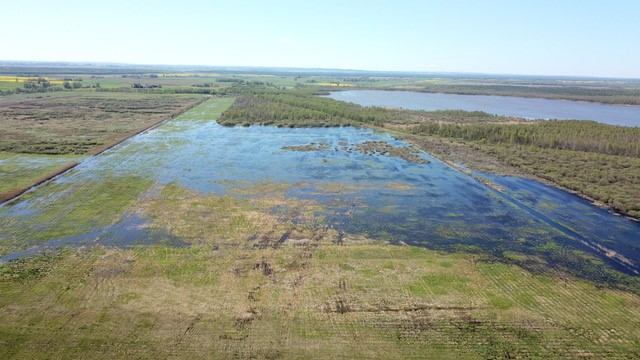
In Kaliningrad-Region, rewetting is being prepared at 2 plots, Vishnyovy and Vittgirinskoy peatlands.
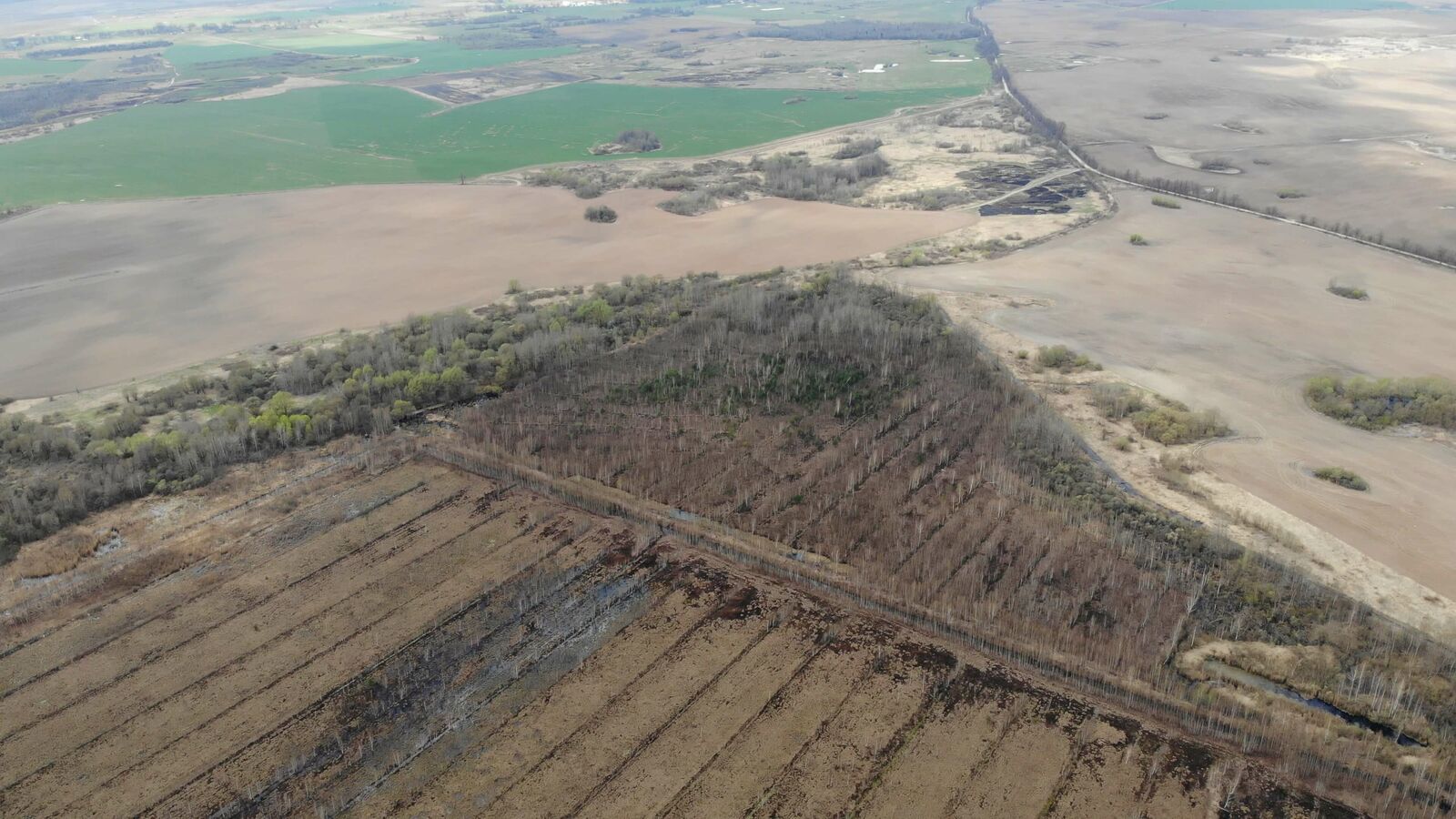
Vittgirrenskoje
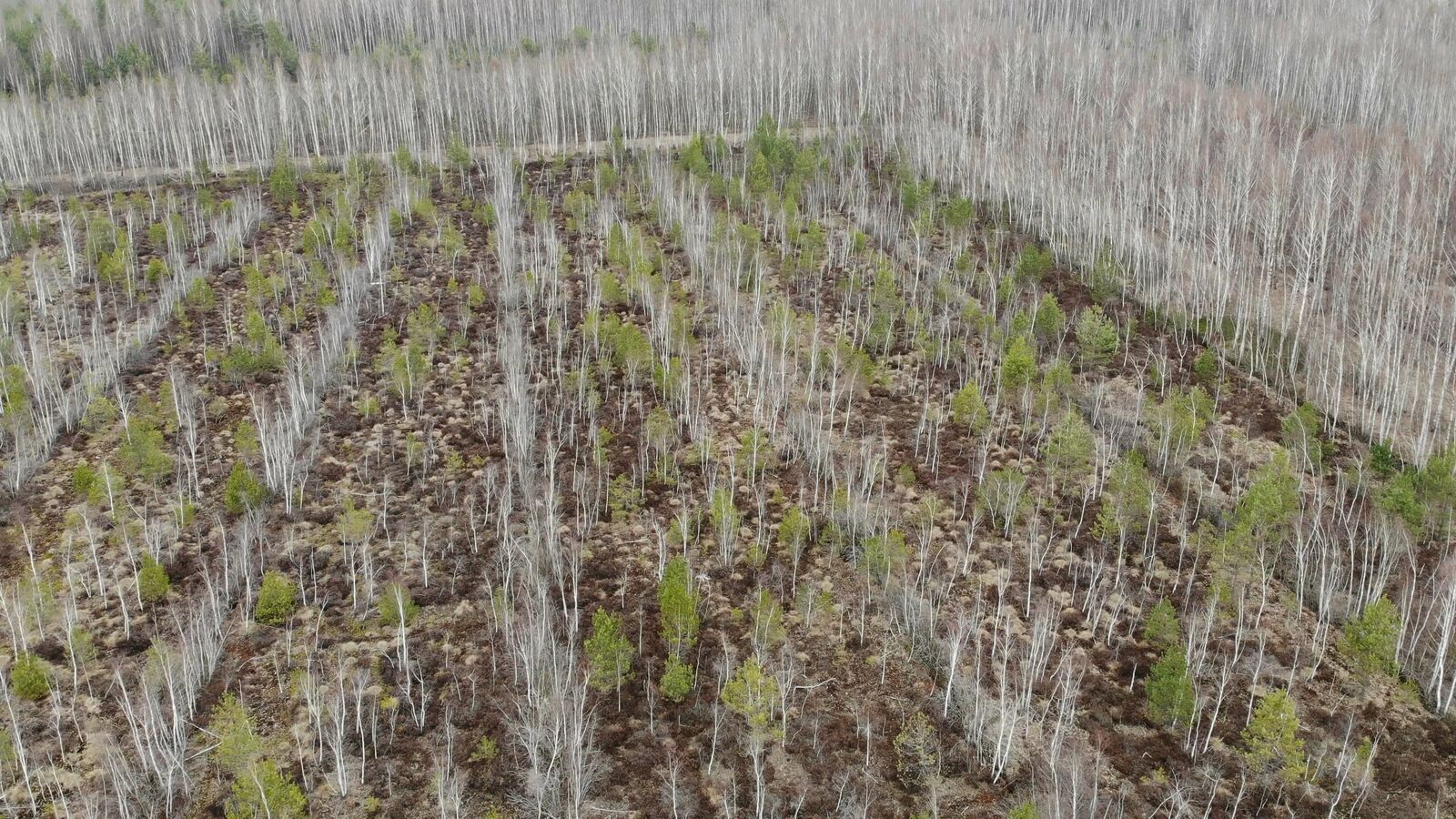
Vishnyove
4.3 Cross sectoral dialogue on paludiculture biomass utilisation
An overview on the potential of using biomass from wet peatlands for biogas production is given here. A more comprehensive publication has been developed within the project by the team of the BUT: Czubaszek, R., Wysocka-Czubaszek, A., Wichtmann, W., Banaszuk, P. (2021): Specific Methane Yield of Wetland Biomass in Dry and Wet Fermentation Technologies. Energies 2021, 14, 8373. This can be downloaded here: https://doi.org/10.3390/en14248373 .
Thursday, 23.01.2020, Warsaw, SGGW, 10:00 – 13:30
Presentations:
Mateusz Grygoruk (SGGW) & Wendelin Wichtmann (Uni Greifswald): Introduction
Pål Martin Eid (Miljødirektoratet, Norway): National Bog Restoration Project in Norway – technical guidelines and lessons
Mateusz Grygoruk (SGGW): Hydrological monitoring of restored bogs in Norway
Julia Kharanzhevskaya (SibRIAP-RAS, Tomsk, Russia): Some Siberian mires also require restoration – documenting degraded mires of the Tomsk Oblast
Interesting presentations were given on technical/practical aspects of rewetting of peatlands. Examples from different peatland restoration sites in Norway and Western Siberia were presented. Positive and negative practical experiences have been reported. One example showed that instalments of a 7 years old restoration project had to be removed and new techniques (peat dams partly filling ditches) had to be constructed. Recommendations for further optimisation of practical rewetting were given. Effectiveness of measures should be visible in vegetation change at least after 3 years of implementation.
Bialystok University of Technology; Faculty of Civil and Environmental Engineering (Wiejska 45E)
Presentations:
Jan Peters: Welcome. The role of peatlands in the landscape
Wendelin Wichtmann: Introduction to the DESIRE project
Andrzej Kamocki: Purpose and scope of the DESIRE project in the Polish part of the Neman river basin
Mateusz Grygoruk: Methodology, goals and selected problems of wetlands restoration– an overview
Minutes and summary of discussion:
The presentations of project partners were considered as a starting point of the discussion with the associated partners. Participants from Biebrza National Park, Ministry of Maritime Economy and Inland Navigation, and Polish Waters (the agency in Bialystok) commented on the main statements communicated in presentations. Presented ideas on the potential using wetlands as landscape water filters were acknowledged by the audience. However, the experts of wetland restoration in the Biebrza Valley commented that stakeholder pressure remains a key challenge in implementing mire restoration measures. Most of the landowners seem unaware that continuous dry-up of the drained systems will result in the loss of their productivity. Moreover, their habitat values will be impaired.
Presentations:
Mateusz Grygoruk: On the experience of the on the dry peatlands rewetting projects
Piotr Banaszuk: On the technical aspects of the peatlands rewetting
During this meeting, possible peatlands of the Kaliningrad region suitable for rewetting and paludiculture and further project activities were discussed:
-
- The Wittgirrenskoye peatland located on lands belonging to the Agency on the regional property (the Kaliningrad region Government) and leased to a farm was discussed. The new tenant of this territory is interested in the project activities, as he intends to use the whole plot for growing cranberries for harvest.
- The Deputy Director of the associated organization «Balt AGP» suggested using peatlands located in the eastern part of the region for rewetting and paludiculture.
- A representative of the Ministry of Natural Resources and Ecology of the Kaliningrad region (Department of Forestry and Wildlife Use) asked about the benefits of the Kaliningrad region after implementation of the project. The advantages of rewetting were discussed.
- Further steps of the DESIRE project: to inspect the Wittgirinskoye dry peatland and the territory of the Slavsky District (Rzhevka and Lugovaya rivers) together with Polish project partners.
A workshop on energetic utilisation of biomass from paludiculture took place online at Greifswald University on November 8, 2021. It was attended by 32 participants. The event gave an update and provided new insights into biomass conversion to heat, biogas and other energy products. The summary to the workshop on the energetic use of biomass can be found here.
Cranberries can be cultivated on rewetted peatlands. DESIRE aimed to make clear conditions of cranberry cultivation and management of cranberry sites in a cranberry stakeholder workshop on March 23, 2021. The discussion of the possibility for cranberry paludiculture development was addressed mainly to stakeholders in Kaliningrad Region, where the most suitable conditions seem to be. About 40 people participated in this event. The summary of the workshop can be found here.
Other workshops/stakeholder meetings in 2019
BY (in Brest, 15/16th April):
Main topics/contents: Potential sites for rewetting and paludiculture implementation, inclusion of Belarusian peatlands into the GIS database, excursion to potential project sites.
KG (in Kaliningrad, 24th June):
Participants: Relevant Ministries were represented by vice ministers and many other representatives from different organisations and administration. An overview on project goals and activities was provided.
LT (3 meetings in Vilnius):
Ministry of Environment meeting:
Participants: Officials responsible for pollution and water quality, Nature Conservation Agency (AO). Project partners presented their view towards the importance of peatlands, and the need to cooperate to include peatlands as part of measures under the new CAP.
Main topics: ongoing planning of new CAP measures at the Ministry of Agriculture.
Ministry of Agriculture meeting (11th June)
Participants: Farmers association, Association of Agriculture Cooperatives, Forest Owners Association, State Land Service Reclamation Department, State Service of Protected Areas, State Forestry Service, MoA divisions, responsible for EU subsidies etc.
Main topics: Protection of organic soils, new agro-environmental schemes for the Common Agriculture Policy after 2020 including paludiculture as the new option, review of various proposals by the MoA (on direct payments, ECO schemes, agro-environmental measures).
Outcomes: Proposal on measures for future CAP was developed and submitted to the Ministry in June 2019. This proposal was also included in the proposal on future CAP of the Coalition of nature conservation NGOs.
Nature Conservation Agency's Hydrographic Network division meeting (26th June)
Project partners provided an insight and demonstration of the planned GAP analysis. Furthermore, they presented planned activities in the DESIRE project and discussed cooperation.
Outcomes: Agreement on future cooperation with the intergovernmental panel on Neman river catchment. The Agency supported the idea of demo site installment, but raised questions about the need to prove the role of peatlands in nutrient capture.







